Input interpretation

Cl_2 (chlorine) + H_2 (hydrogen) ⟶ HCl (hydrogen chloride)
Balanced equation
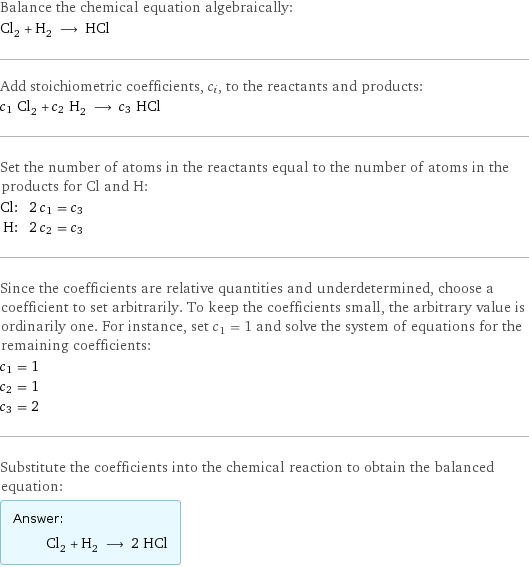
Balance the chemical equation algebraically: Cl_2 + H_2 ⟶ HCl Add stoichiometric coefficients, c_i, to the reactants and products: c_1 Cl_2 + c_2 H_2 ⟶ c_3 HCl Set the number of atoms in the reactants equal to the number of atoms in the products for Cl and H: Cl: | 2 c_1 = c_3 H: | 2 c_2 = c_3 Since the coefficients are relative quantities and underdetermined, choose a coefficient to set arbitrarily. To keep the coefficients small, the arbitrary value is ordinarily one. For instance, set c_1 = 1 and solve the system of equations for the remaining coefficients: c_1 = 1 c_2 = 1 c_3 = 2 Substitute the coefficients into the chemical reaction to obtain the balanced equation: Answer: | | Cl_2 + H_2 ⟶ 2 HCl
Structures

+ ⟶
Names

chlorine + hydrogen ⟶ hydrogen chloride
Reaction thermodynamics
Enthalpy
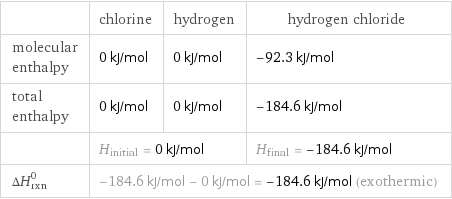
| chlorine | hydrogen | hydrogen chloride molecular enthalpy | 0 kJ/mol | 0 kJ/mol | -92.3 kJ/mol total enthalpy | 0 kJ/mol | 0 kJ/mol | -184.6 kJ/mol | H_initial = 0 kJ/mol | | H_final = -184.6 kJ/mol ΔH_rxn^0 | -184.6 kJ/mol - 0 kJ/mol = -184.6 kJ/mol (exothermic) | |
Gibbs free energy
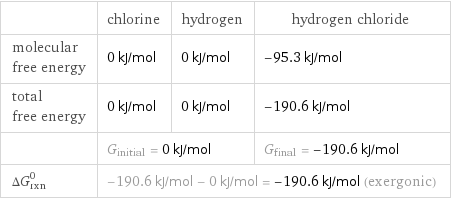
| chlorine | hydrogen | hydrogen chloride molecular free energy | 0 kJ/mol | 0 kJ/mol | -95.3 kJ/mol total free energy | 0 kJ/mol | 0 kJ/mol | -190.6 kJ/mol | G_initial = 0 kJ/mol | | G_final = -190.6 kJ/mol ΔG_rxn^0 | -190.6 kJ/mol - 0 kJ/mol = -190.6 kJ/mol (exergonic) | |
Entropy
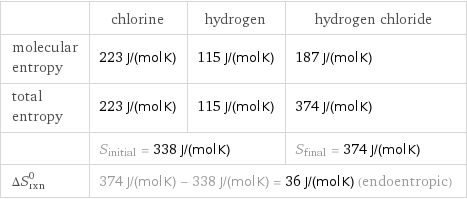
| chlorine | hydrogen | hydrogen chloride molecular entropy | 223 J/(mol K) | 115 J/(mol K) | 187 J/(mol K) total entropy | 223 J/(mol K) | 115 J/(mol K) | 374 J/(mol K) | S_initial = 338 J/(mol K) | | S_final = 374 J/(mol K) ΔS_rxn^0 | 374 J/(mol K) - 338 J/(mol K) = 36 J/(mol K) (endoentropic) | |
Equilibrium constant
![Construct the equilibrium constant, K, expression for: Cl_2 + H_2 ⟶ HCl Plan: • Balance the chemical equation. • Determine the stoichiometric numbers. • Assemble the activity expression for each chemical species. • Use the activity expressions to build the equilibrium constant expression. Write the balanced chemical equation: Cl_2 + H_2 ⟶ 2 HCl Assign stoichiometric numbers, ν_i, using the stoichiometric coefficients, c_i, from the balanced chemical equation in the following manner: ν_i = -c_i for reactants and ν_i = c_i for products: chemical species | c_i | ν_i Cl_2 | 1 | -1 H_2 | 1 | -1 HCl | 2 | 2 Assemble the activity expressions accounting for the state of matter and ν_i: chemical species | c_i | ν_i | activity expression Cl_2 | 1 | -1 | ([Cl2])^(-1) H_2 | 1 | -1 | ([H2])^(-1) HCl | 2 | 2 | ([HCl])^2 The equilibrium constant symbol in the concentration basis is: K_c Mulitply the activity expressions to arrive at the K_c expression: Answer: | | K_c = ([Cl2])^(-1) ([H2])^(-1) ([HCl])^2 = ([HCl])^2/([Cl2] [H2])](../image_source/a87df7728649a3740ddc4a65380a134d.png)
Construct the equilibrium constant, K, expression for: Cl_2 + H_2 ⟶ HCl Plan: • Balance the chemical equation. • Determine the stoichiometric numbers. • Assemble the activity expression for each chemical species. • Use the activity expressions to build the equilibrium constant expression. Write the balanced chemical equation: Cl_2 + H_2 ⟶ 2 HCl Assign stoichiometric numbers, ν_i, using the stoichiometric coefficients, c_i, from the balanced chemical equation in the following manner: ν_i = -c_i for reactants and ν_i = c_i for products: chemical species | c_i | ν_i Cl_2 | 1 | -1 H_2 | 1 | -1 HCl | 2 | 2 Assemble the activity expressions accounting for the state of matter and ν_i: chemical species | c_i | ν_i | activity expression Cl_2 | 1 | -1 | ([Cl2])^(-1) H_2 | 1 | -1 | ([H2])^(-1) HCl | 2 | 2 | ([HCl])^2 The equilibrium constant symbol in the concentration basis is: K_c Mulitply the activity expressions to arrive at the K_c expression: Answer: | | K_c = ([Cl2])^(-1) ([H2])^(-1) ([HCl])^2 = ([HCl])^2/([Cl2] [H2])
Rate of reaction
![Construct the rate of reaction expression for: Cl_2 + H_2 ⟶ HCl Plan: • Balance the chemical equation. • Determine the stoichiometric numbers. • Assemble the rate term for each chemical species. • Write the rate of reaction expression. Write the balanced chemical equation: Cl_2 + H_2 ⟶ 2 HCl Assign stoichiometric numbers, ν_i, using the stoichiometric coefficients, c_i, from the balanced chemical equation in the following manner: ν_i = -c_i for reactants and ν_i = c_i for products: chemical species | c_i | ν_i Cl_2 | 1 | -1 H_2 | 1 | -1 HCl | 2 | 2 The rate term for each chemical species, B_i, is 1/ν_i(Δ[B_i])/(Δt) where [B_i] is the amount concentration and t is time: chemical species | c_i | ν_i | rate term Cl_2 | 1 | -1 | -(Δ[Cl2])/(Δt) H_2 | 1 | -1 | -(Δ[H2])/(Δt) HCl | 2 | 2 | 1/2 (Δ[HCl])/(Δt) (for infinitesimal rate of change, replace Δ with d) Set the rate terms equal to each other to arrive at the rate expression: Answer: | | rate = -(Δ[Cl2])/(Δt) = -(Δ[H2])/(Δt) = 1/2 (Δ[HCl])/(Δt) (assuming constant volume and no accumulation of intermediates or side products)](../image_source/61aa437dd4864e80702b6d085d363959.png)
Construct the rate of reaction expression for: Cl_2 + H_2 ⟶ HCl Plan: • Balance the chemical equation. • Determine the stoichiometric numbers. • Assemble the rate term for each chemical species. • Write the rate of reaction expression. Write the balanced chemical equation: Cl_2 + H_2 ⟶ 2 HCl Assign stoichiometric numbers, ν_i, using the stoichiometric coefficients, c_i, from the balanced chemical equation in the following manner: ν_i = -c_i for reactants and ν_i = c_i for products: chemical species | c_i | ν_i Cl_2 | 1 | -1 H_2 | 1 | -1 HCl | 2 | 2 The rate term for each chemical species, B_i, is 1/ν_i(Δ[B_i])/(Δt) where [B_i] is the amount concentration and t is time: chemical species | c_i | ν_i | rate term Cl_2 | 1 | -1 | -(Δ[Cl2])/(Δt) H_2 | 1 | -1 | -(Δ[H2])/(Δt) HCl | 2 | 2 | 1/2 (Δ[HCl])/(Δt) (for infinitesimal rate of change, replace Δ with d) Set the rate terms equal to each other to arrive at the rate expression: Answer: | | rate = -(Δ[Cl2])/(Δt) = -(Δ[H2])/(Δt) = 1/2 (Δ[HCl])/(Δt) (assuming constant volume and no accumulation of intermediates or side products)
Chemical names and formulas

| chlorine | hydrogen | hydrogen chloride formula | Cl_2 | H_2 | HCl Hill formula | Cl_2 | H_2 | ClH name | chlorine | hydrogen | hydrogen chloride IUPAC name | molecular chlorine | molecular hydrogen | hydrogen chloride
Substance properties
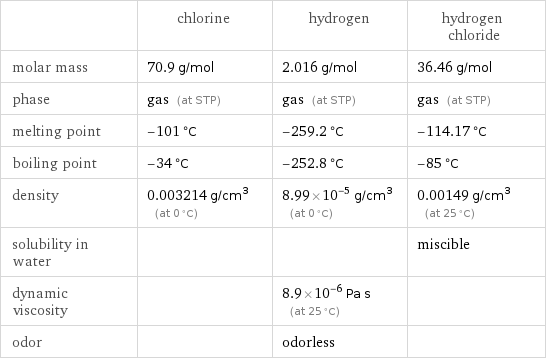
| chlorine | hydrogen | hydrogen chloride molar mass | 70.9 g/mol | 2.016 g/mol | 36.46 g/mol phase | gas (at STP) | gas (at STP) | gas (at STP) melting point | -101 °C | -259.2 °C | -114.17 °C boiling point | -34 °C | -252.8 °C | -85 °C density | 0.003214 g/cm^3 (at 0 °C) | 8.99×10^-5 g/cm^3 (at 0 °C) | 0.00149 g/cm^3 (at 25 °C) solubility in water | | | miscible dynamic viscosity | | 8.9×10^-6 Pa s (at 25 °C) | odor | | odorless |
Units
